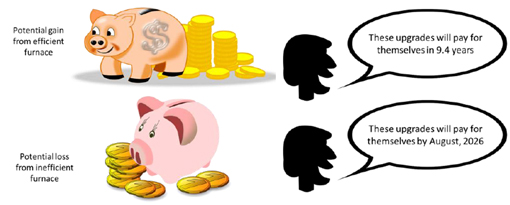ACEEE har gjort en nyttig rapport “How to Talk about Home Energy Upgrades” som nästan känns som om de haft en aning om att priset för ekonomi till Nobels minne skulle gå till en beteendeekonom.
Den visar hur man bör argumentera på ett språk som mottagaren (kunden) kan och vill förstå. Till exempel att förstå att kunden är “förlustskyeende” snarare än vinstmaximerande och även om det är samma sak är det ett starkare argument att man kan undvika en förlust än att göra en vinst (se bild nedan)! Eller att man har lättare att ta till sig en uppgift on när man får igen sin investering än att räkna ut det själv (samma bild nedan).
We recommend that home energy assessors:
* Provide an interesting and engaging experience to homeowners when conducting the assessment
* Listen to homeowners and carefully tailor their discussion of upgrades to address the homeowners specific concerns and motivations
* Attempt to focus on nonfinancial benefits
* Develop rapport with customers and help them navigate through the upgrade process from start to finish
* Apply subtle message framing strategies to maximize the effectiveness of the information presented to homeowners

Skrivet av Hans Nilsson, 2017-10-17.
(0) Kommentarer • Permalink
